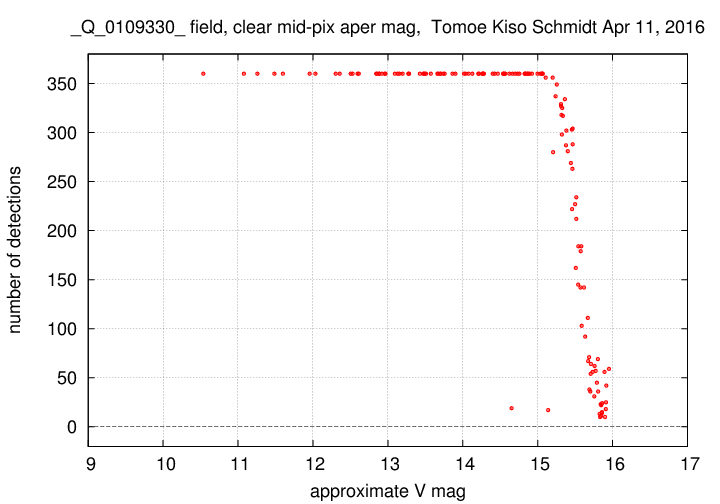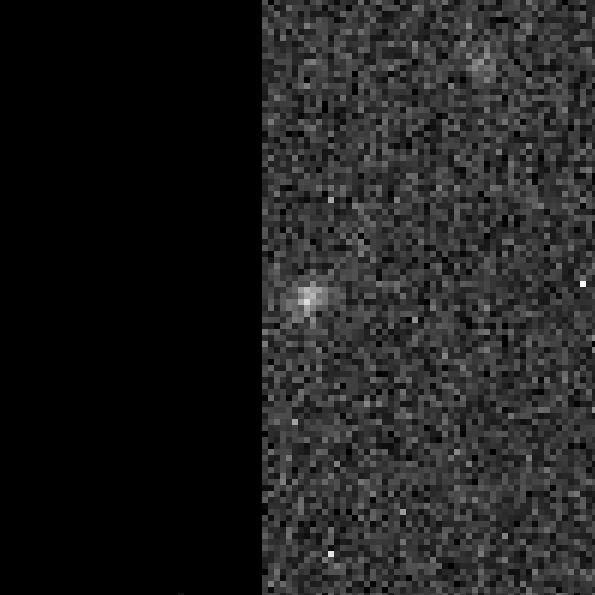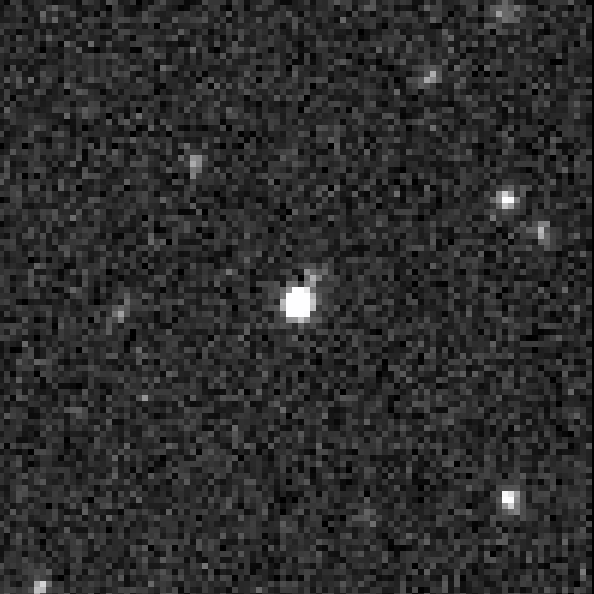
If we are interested in identifying transient sources in the Tomoe data, we need to understand the properties of constant sources properly. This is a short report describing some statistics of objects in the Tomoe prototype data from April, 2016.
I started with the composite FITS file TMPM0109330.fits which contains 360 Tomoe images taken during a period centered on JD 2457490.1051285 = 2016 April 11 14:31:23. The field location is
(J2000) RA = 196.5758 Dec= -16.2223
I ran these data through my pipeline, which performed some cleaning operations, identified and measured stars in each image, and ran the measurements through inhomogeneous ensemble photometry. Only stars with at least 10 detections were kept in the ensemble. This is a pipeline parameter which can be varied as desired.
One of the output files contains a list of every detection of every star in the ensemble. I analyzed that information and tabulated the number of detections as a function of approximate V-band magnitude. The results are shown below:

The general conclusion is "just as expected." Bright objects are detected in ALL images, and faint objects in few. The transition region shows a roughly linear trend in number of detections vs. magnitude, which will turn out to be convenient later, I guess.
There are exactly two objects which are outliers: the two objects around mag V=14.7 and V=15.2. Each has roughly 20 detections, and so is not likely to be random noise ... but each has many fewer detections than other objects of similar magnitudes. My guess is that these may be faint objects close to brighter ones, or close to the edge of the field, so that they can only be detected in particularly good seeing, or when the telescope shifts a tiny bit in one direction.
I will investigate.
This candidate is only occasionally detected as a combination of two factors:
My code for detecting stars will ignore objects which are very close to the edge of an image. This object is only about 8 or 9 pixels from the edge. In most images, it so close that it triggers the "edge warning" and is ignored; but occasionally, small drifts in the position of the telescope will push it far enough from the edge that is is accepted.
Out of the 360 images, this candidate was found in the following:
47 48 89 116 122 182 209 212 214 220 224 284 308 327 332 334 355

It will therefore be necessary to flag as poor candidates which are within a certain distance of the edge of the frame. That is easily done as part of the candidate selection process.
This candidate is only occasionally detected because it is a close companion to a brighter star. The candidate has mag V = 14.65, but its companion is V = 12.95. The faint star is only 12 pixels away from its brighter neighbor, which is about (2.4 x FWHM). Out of the 360 images, this candidate was found in the following:
17 18 21 42 52 65 71 75 80 100 175 205 206 222 263 301 326 331 335
As you can see, there are no obvious patterns in this list -- nor are the detections all consecutive or nearly so. These are both good news, as it should help us to distinguish false candidates from real transient events.

The relatively fast procedure I use to detect and measure stars will fail if an object is too close to a brighter neighbor, so we can expect to see many candidates of this type. It will therefore be necessary to flag as poor candidates which are within a certain distance of brighter stars. That is easily done as part of the candidate selection process.